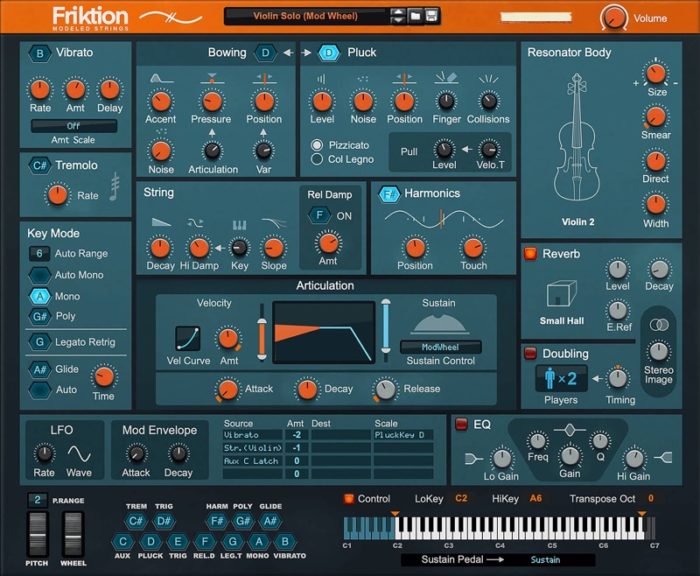
Friktion is a new Rack Extension created by Reason Studios. It’s a physical modelling synthesizer. This is what Reason Studios says about their own nww product:
Use Friktion to create string parts that are far closer to real-life bowed instrument performances than you could ever get with any sample library.
Reason Studios – Friktion
Better than a sample library?
Many of my colleagues which are composers are using sample libraries because strings are still used a lot in film and media productions. Most media composers I know have added many great sounding (and expensive!) string libraries to their arsenal. But although I have been impressed by the quality of these libraries, it never forced me to go into that direction as well.
Only once did I compose a track for strings (using the Orkestra Sound Bank which is included in Reason): Blowing Snow. This track is used a lot I should say in videos, radio and television documentaries.
The dynamic expressiveness of Friktion is mind blowing. I feel inspired to use it in my own work. Even in a very critical minimal setting Friktion sounds fantastic and real. Listen for example to this demosong:
And this one (made by Ryan Harlin, banjo and fiddle are from Friktion):
I designed a couple of patches for Friktion
Three of my patches are included in Friktion:
- Plucked Rock Bass
- Airy Ensemble (Mod Wheel)
- Eleanor Celli (Mod Wheel)
The forth patch I created for Friktion, Plucked Jazz Bass, was not included because Reason Studios felt it was too close to the Plucked Bass patch which was already created for the product. See for your yourself, you can download my patch below. It mimics the sound of an old stand up bass, it’s got a dryness in tone which I love.
Plucked Jazz Bass - byM (2.1 KiB, 850 hits)
Beyond real
The cool thing about Friktion is not only that it sounds real, but that it goes beyond what sounds real. So it’s also a creative tool for creating new sounds which sound as organic as real acoustic instrument but which don’t exist in real life.
In this video Ryan Harlin explore the realness as well as the creative possibilities of Friktion:
Also check out the cool review Peter Kirn published on CDM:
Tell me what you think of Friktion!

4 Comments
Tell me what you think of Friktion: I exactly share your opinion. Friction sounds very organic and fills the world of artificial sounds with life. You have the feeling to play a real instrument. It would be very welcome if resonstudios would continue working in this direction. I like your song “blowing snow” very much. I have already recorded and published some songs with friction: http://linktr.ee/falkbossa
I have been loving Friktion and used your Airy Ensemble patch before I even knew your site existed. Was excited to download your plucked bass but the link appears to be broken. Any chance you could fix it?
Will look into it. Need to fix these downloads indeed. Thanks for mentioning it! And keep you posted.
By Post Author
Thank you for the article, Marco, are you still using Fricktion in 2024?
Physically modelled instruments are becoming increasingly more standard, which is a nice change after decades of moving from one sample library to another, because “this one has detache, but not sordino, but that other one has sordinos, although it doesn’t have have as many dynamics and there’s too much reverb”. The increased expression, realism, round-robins, potentially unlimited range of possible articulations and timbres, and last but not least, no baked-in reverb (!) makes modelling very tempting!
In addition to Fricktion, Audio Modeling and Sample Modeling also make physically modelled strings, albeit much more expensive; with Fricktion one gets both solo and ensemble strings for a quarter of their prices, and extendable instrument possibilities, like the Fiddle and Banjo in Ryan’s example.
Have you heard their demos and how do they compare to Fricktion, Marco? It seems Fricktion may be easier to master, but can it hold its’ own against those two?
Also, do you know if the ensemble-feature in Fricktion avoids phasing? I know that one of the other developers includes a phase correlation-meter to help avoid phasing issues with their ensemble-feature. Apparently the one thing physical models may sometimes struggle with is phasing issues when multiple instruments are overlaid!